Operation of police powers under the Terrorism Act 2000 and subsequent legislation: Arrests, outcomes, and stop and search, Great Britain, quarterly update to September 2015
Published 10 December 2015
Applies to England, Scotland and Wales
1. Key findings
1.1 Arrests and outcomes
There were 315 terrorism-related arrests in the year ending September 2015, an increase of a third compared with the previous year. This was driven by:
- arrests of females more than doubling from 21 arrests in the year ending September 2014 to 50 arrests in the year ending September 2015
- a 31% increase in the number of arrests for international-related terrorism
- increasing arrests of persons aged ’21-24’ and ’30 and over’
The number of under 18 year olds arrested for terrorism-related offences almost doubled from 8 in the year ending September 2014, to 15 in the year ending September 2015.
Thirty-nine per cent (124) of those arrested in the year ending September 2015 have been charged, with a further 22% (68) released on bail. Thirty-seven per cent (115 arrestees) were released without charge.
1.2 Court proceedings
In the year ending September 2015, there were 51 persons proceeded against for terrorism-related offences (up from 30 in the previous year). Of these, 43 were convicted and 8 were acquitted. Of the 43 persons convicted, 28 entered a guilty plea.
1.3 Terrorist and extremist prisoners
As at 30 September 2015, there were 170 persons in custody for terrorism-related offences and domestic extremism/separatism. This was an increase of 22 persons compared with the same time last year (as at 30 September 2014), but a decrease of 14 compared with the number of persons in custody at the end of the previous quarter (30 June 2015).
1.4 Stop and search
In the year ending September 2015:
- the MPS carried out 473 stops and searches under section 43 of the Terrorism Act (TACT) 2000; this was an increase of 31% compared with the previous year; increases were seen for most ethnic groups, but the number of people searched who considered themselves to be ‘Asian or Asian British’ saw the largest increase, up 53% compared with the previous year
- the proportion of persons searched who were subsequently arrested was 8%, up 2 percentage points compared with the previous year
- the number of examinations under Schedule 7 to TACT 2000 fell by 22% from around 37,000 to 29,000; over the same period, the number of resultant detentions almost tripled from around 680 to 1,800
2. Introduction
2.1 User feedback
Following the user feedback survey, and other feedback from users, we have made a number of changes to improve this release and better meet user needs. The changes include:
- making the publication more timely; previously data were published 6 months after the period to which they refer. We have worked with data providers to reduce this to 3 months for this release; additional information will be added to the user guide
- amending commentary in the quarterly publications to focus on the key points, making the release shorter and more focused; all the existing data are provided in the data tables
- amendments to the flow chart in Annex A to include only key information, and outline the process through the criminal justice system
2.2 Overview
This release covers the use of police powers under terrorism and terrorism-related legislation in Great Britain in the most recent 9 quarters to September 2015. The release is broken down into 4 sections.
The ‘arrests and outcomes’ section uses data provided by the ACPO Counter Terrorism Coordination Centre (ACTCC) and includes statistics for Great Britain on:
- arrests for terrorism-related activity, and outcomes (such as charges and convictions) following arrests
- the legislation used to bring charges and convictions
- gender, age, ethnicity, and nationality of those arrested, charged and convicted
- the type of terrorism involvement of those arrested, charged and convicted (such as whether the individual had links to international, domestic, or Northern-Ireland-related terrorism)
A flow chart summarising this section can be found in Annex A.
The ‘court proceedings’ section uses data from the Crown Prosecution Service (CPS) and includes statistics for England and Wales on:
- the number of persons proceeded against by the CPS for terrorism-related activity
- the legislation under which persons have been prosecuted and convicted
- the sentence length given to those convicted for terrorism-related offences
The ‘terrorist and extremist/separatist prisoners’ section uses data from the National Offender Management Service (NOMS) and the Scottish Prison Service (SPS) and includes statistics for Great Britain on:
- the number of persons in custody for domestic extremism and terrorism-related offences
- the ethnicity, nationality and religion of those in custody
- the number of persons released from custody
The ‘stop and search’ section uses data provided by the Metropolitan Police Service (MPS) and the National Counter Terrorism Policing Headquarters (NCTPHQ) and includes statistics on:
- the number of stops and searches carried out by the MPS under section 43 of the Terrorism Act (TACT) 2000
- the number of examinations and subsequent detentions made in Great Britain under Schedule 7 to TACT 2000
- data on goods examinations, strip searches and postponement of questioning refusals under Schedule 7 to TACT 2000 which are published for the first time in this release
Further details on this release, including a summary of the criminal justice process, details of the terrorism legislation covered and definitions of the different categories of terrorists can be found in the user guide. A flow chart summarising the ‘arrests and outcomes’ section of this release can be found in Annex A.
Further information on data quality and interpreting the figures in this release can also be found in the user guide.
3. Arrests and outcomes
Statistics presented in this section represent the number of persons arrested by police in Great Britain, where there is suspicion of involvement in terrorist activity, either at the time of arrest, or at a subsequent point in the investigation. In some cases after a terrorism-related arrest, evidence may emerge that suggests a suspect does not have links to terrorist activity, but has committed an offence. These cases are included in the arrest data as non-terrorism-related charges and/or convictions. Outcomes following these arrests are also included in the statistics and show the number of arrests that led to a charge or prosecution, as well as other outcomes. All data in this section are based on the date of arrest. This allows users to see the outcomes of all of the arrests in a specific period, (such as how many led to a charge and conviction).
As cases progress over time, figures are likely to change. This is particularly relevant for more recent quarters where a larger number of cases will be incomplete (‘released on bail’, or ‘awaiting prosecution’). While the effect on the arrests total should be small, the number of charges and convictions will be significantly lower for more recent quarters as a greater number of cases would not have reached the point of charge or conviction yet. These quarters will be updated in future publications. As this publication includes more timely data than previous releases (see [section 2.1]), there are likely to be more incomplete cases than in previous publications.
Data are provided to the Home Office by ACTCC and are taken from a live database. The data cover the most recent 9 quarters up to September 2015 and are correct at the time of data provision to the Home Office (19 October 2015).
A flow chart summarising this section is included in Annex A. This follows individuals from the point of arrest through to charge (or other outcome), and prosecution. Tables A.01 to A.13 include data on arrests and outcomes.
3.1 Arrests
In the year ending September 2015, there were 315 terrorism-related arrests in Great Britain. This was an increase of 34% on the previous year. The increase was driven by a particularly large number of arrests in 2 of the 4 most recent quarters – October to December 2014 (106) and April to June 2015 (94). The most recent quarter saw a fall in the number of arrests to around half that of the quarter before (94 down to 48).
The wide-ranging nature of terrorism investigations that the police undertake can lead to fluctuations in the number of arrests from one quarter to the next. Furthermore, individual investigations involving multiple suspects are likely to cause an increase in the figures more than investigations involving small numbers of suspects.
Figure 3.1: Arrests for terrorism-related offences, by legislation, Great Britain

Not supplied by author.
Source: Home Office, data table A.01.
3.2 Charges
Data in more recent quarters are likely to have a larger proportion of cases that are incomplete (such as cases where the suspect is released on bail). This is shown in Figure 3.2 where a large proportion of cases in the most recent quarter have a suspect who has been released on bail (58%), compared with 28% in the previous quarter (April to June) and only 6% of the year to September 2014 total. As time passes, cases will progress and the number of charges (and other outcomes) will increase, while the number released on bail will decrease. For this reason, the charge rate in more recent quarters is likely to be lower than older quarters. Charge rates cannot be compared on a like-for-like basis until all cases within the time period have been completed.
Of the 315 persons arrested in the year ending September 2015, 124 (39%) have been charged with an offence, and 115 (37%) have been released without charge. A further 68 (22%) persons were bailed to return and 8 (3%) faced alternative action.
Figure 3.2: Breakdown of outcomes at the point of charge, following a terrorism-related arrest, Great Britain1
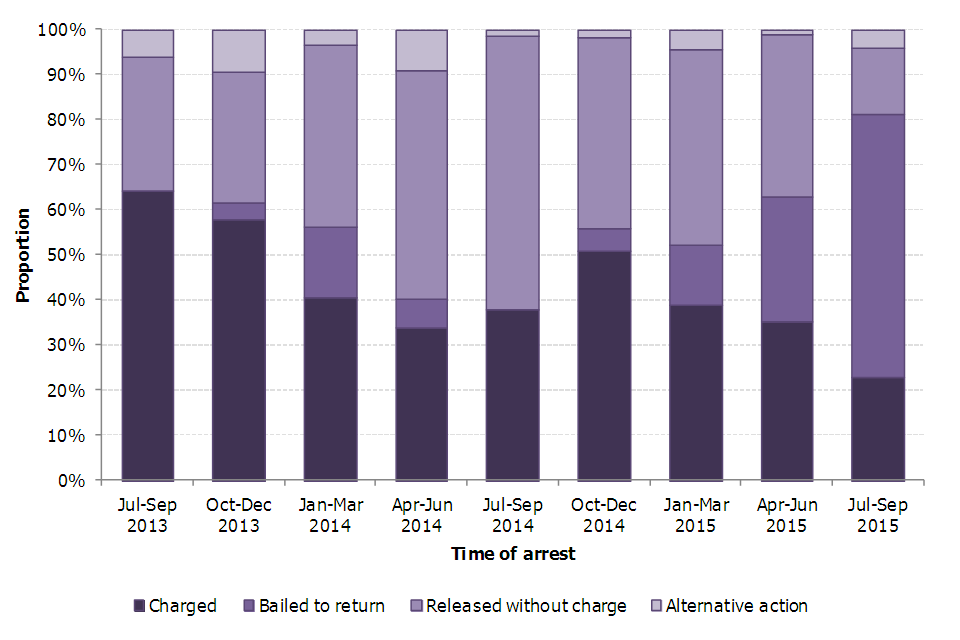
Not supplied by author.
Source: Home Office, data table A.03.
Notes:
- Alternative action includes cautions, action under mental health legislation, transfer to immigration authorities etc. See table A.03 for a complete list.
Of the 124 persons charged in the year ending September 2015, 90% (111) have been charged with terrorism-related offences, up 7 percentage points on the 83% terrorism-related charges in the previous year to the highest rate on record. Since 11 September 2001 (when the data collection was set up), 66% of charges have been terrorism-related. The figures show that the police are charging suspects with a terrorism-related charge in an increasing proportion of cases.
3.3 Convictions
Of the persons arrested for terrorism-related offences in the year ending September 2015, 111 have been charged with a terrorism-related offence. Thirty-six of these have been prosecuted (at the time of data provision to the Home Office, 19 October 2015), 35 of whom were convicted. A further 74 are awaiting prosecution, and one was not proceeded against.
Figure 3.3: Outcomes following a charge for a terrorism-related offence, Great Britain, year ending September 20151,2
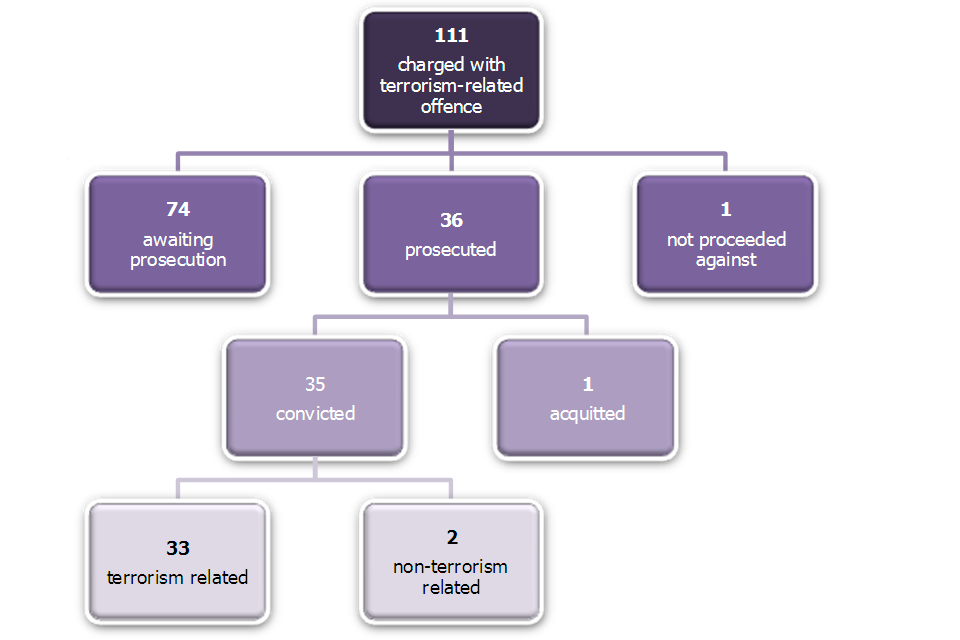
Not supplied by author.
Source: Home Office, data table A.06c.
Chart notes:
- Based on time of arrest.
- A more detailed flow chart can be found in Annex A.
3.4 Demographics of persons arrested
This section includes statistics on the number of persons arrested by different demographic characteristics as well as category of prisoner. It includes data on:
- gender
- age
- ethnic appearance
- nationality
- terrorist category
Gender
In the year ending September 2015, the number of females arrested for terrorism-related offences more than doubled (from 21 to 50) compared with the previous year. Females accounted for 16% of arrests throughout the year, an increase of 7 percentage points on the previous year. The majority of the increase in the number of women getting arrested has been linked to international-related terrorism.
Since 11 September 2001, only 8% of persons arrested for terrorism-related offences have been female. However, a fifth of arrests of females for terrorism-related offences since September 2001 have occurred in the last year.
Figure 3.4: Arrests for terrorism-related offences by sex, Great Britain
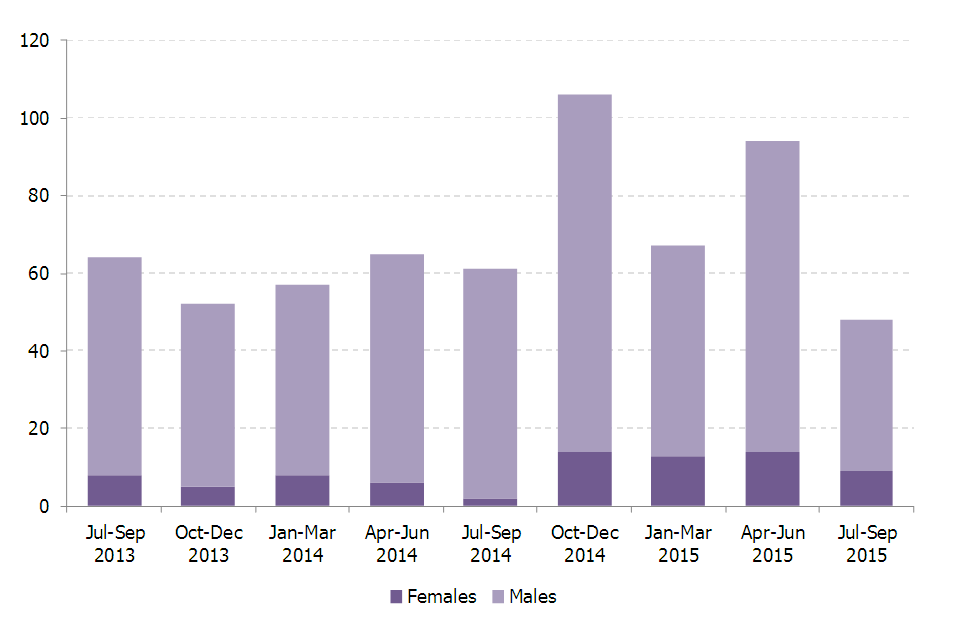
Not supplied by author.
Source: Home Office, data table A.09.
Age
Of the 315 arrests in the year ending September 2015, nearly half were of persons aged 30 and over. There were increases in the number of terrorism-related arrests across all age groups compared with a year ago. However, the ‘21-24’ and the ‘30 and over’ age categories combined accounted for 86% of the overall increase in arrests.
Arrests of those in the ’30 and over’ category increased by 36 in the year ending September 2015, compared with the previous year, while the ’21-24’ age group more than doubled from 31 in the year ending September 2014, to 64 in the year ending September 2015.
There was a notable increase in the number of under 18s arrested for terrorism-related offences, which increased from 8 in the year ending September 2014, to 15 in the year ending September 2015. This was the highest number of arrests in the year to September since the data collection began.
Table 3.01: Age of persons arrested for terrorism-related offences, Great Britain
| Numbers | Great Britain | ||
|---|---|---|---|
| Age group | Year ending September 2014 | Year ending September 2015 | Change between years (numbers) |
| Under 18 | 8 | 15 | 7 |
| 18-20 | 34 | 35 | 1 |
| 21-24 | 31 | 64 | 33 |
| 25-29 | 52 | 55 | 3 |
| 30 and over | 110 | 146 | 36 |
| Total | 235 | 315 | 80 |
Source: Home Office, data table A.09.
Ethnic appearance
The number of terrorism-related arrests increased across all ethnic groups, except ‘other’. In particular there was a 41% increase in the number of persons arrested who considered themselves to be Asian, and a 25% increase in the number that considered themselves to be White.
Nationality
Nearly 4 out of 5 (79%) of those arrested for terrorism-related offences were of British, or British dual nationality. This has increased considerably in recent years. Since 11 September 2001 (when the data collection began), only 56% of those arrested were of British, or British dual nationality.
Terrorist category
In the year ending September 2015, the number of persons arrested for international-related terrorism increased by nearly a third compared with the previous year, to 238 arrests. Arrests relating to international terrorism accounted for around three-quarters of all terrorism-related arrests.
The number of arrests for domestic terrorism increased from 16 to 27 across the same period, while the number of arrests for Northern-Ireland-related terrorism fell from 14 to 5.
3.5 Data tables
Additional data are available in the data tables which accompany this release. These include more detailed breakdowns of the data in this section, as well as data on:
- detentions under section 41 of TACT 2000 table A.02
- the legislation under which persons were charged tables A.05a-c
- the legislation under which persons were convicted tables A.08a-c
4. Court proceedings
This section presents statistics on prosecutions for terrorism-related offences in England and Wales. It provides data on the number of persons prosecuted and convicted, including information on the legislation against which they were prosecuted. It also provides information on the length of sentence that each defendant faces. Statistics presented here are based on the trial completion date and are not directly comparable to the court proceedings data in section 3 (arrests and outcomes).
Data are provided to the Home Office by the Crown Prosecution Service Counter Terrorism Division (CPS CTD). The data cover terrorism-related court cases that were completed in the most recent 9 quarters up to September 2015.
4.1 Court proceedings
In the year ending September 2015, there were 51 trials completed by the CPS CTD for terrorism-related offences. In 43 of these cases, the defendant was convicted. In the remaining 8 cases, the defendant was acquitted.
Figure 4.1: Outcome of terrorism-related trials under TACT and non-TACT legislation1, England and Wales, year ending September 2014 and year ending September 2015
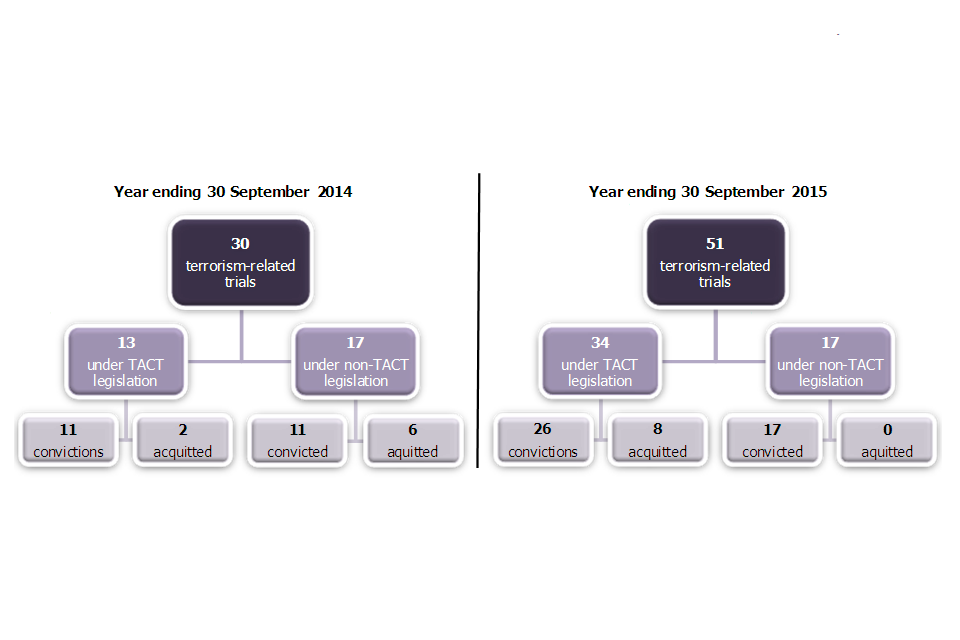
Not supplied by author.
Source: Home Office, data tables C.01-C.03.
Chart Notes:
- Based on the principal offence for which the defendant was prosecuted against.
4.2 Sentencing
A total of 43 persons were convicted of terrorism-related offences in the year ending September 2015. Of these, 28 pleaded guilty and 15 entered a not guilty plea.
Of the 43 persons convicted of terrorism-related offences in the year ending September 2015, 28 were given sentence lengths of less than 4 years, 8 were given sentence lengths between 4 and 10 years, 5 were given sentence lengths of more than 10 years and 1 person was given a life sentence.
Figure 4.2: Sentence length for persons convicted of terrorism-related offences, England and Wales, year ending September 2014 and September 20151,2

Not supplied by author.
Source: Home Office, data tables C.04.
Chart Notes:
- Based on the trial completion date.
- The ‘other’ category includes hospital orders and non-custodial sentences.
4.3 Data tables
Additional data are available in tables C.01 to C.05 which accompany this release. These include more detailed breakdowns of the data in this section, as well as data on:
- the legislation under which persons were proceeded against table C.02
- the legislation under which persons were convicted table C.03
5. Terrorist and extremist/separatist prisoners
Statistics presented in this section give information on the number of persons in custody for terrorism-related offences and domestic extremism/separatism in Great Britain. It includes breakdowns of the ethnicity, nationality and religion of prisoners at a given time. Data on the number of terrorist and extremist/separatist prisoners released from custody are also available in this section.
Data are provided to the Home Office by NOMS and the SPS. The data give information about the prison population at the end of each of the last 9 financial quarters to September 2015.
Data on the number of prisoners released are also provided and cover each of the last 8 quarters up to June 2015. Figures up to September 2015 are not yet available from NOMS. These figures will form a subset of the prison releases statistics which will be published by the Ministry of Justice in their ‘Offender Management Statistics Quarterly’ on 28 January 2016.
Since the last publication, there have been small revisions to the data in tables P.01 and P.05 for some quarters.
5.1 Persons in custody
As at 30 September 2015, there were 170 persons in custody in Great Britain for terrorism-related offences and domestic extremism/separatism. This comprised:
- 137 persons in custody for terrorism-related offences
- 33 persons in custody for domestic extremism/separatism
This was an increase of 22 persons compared to the situation as at 30 September 2014, but a decrease of 14 persons compared with the situation as at 30 June 2015, which was driven by a fall in the number of domestic extremist/separatist prisoners.
The increase in the number of persons in custody for terrorism-related offences between September 2014 and September 2015 is in line with the increased number of terrorism-related arrests (see section 3) and the increase in the number of convictions (see section 4) compared with the previous year.
Figure 5.1: Persons in custody for terrorism-related offences and domestic extremism/separatism, Great Britain
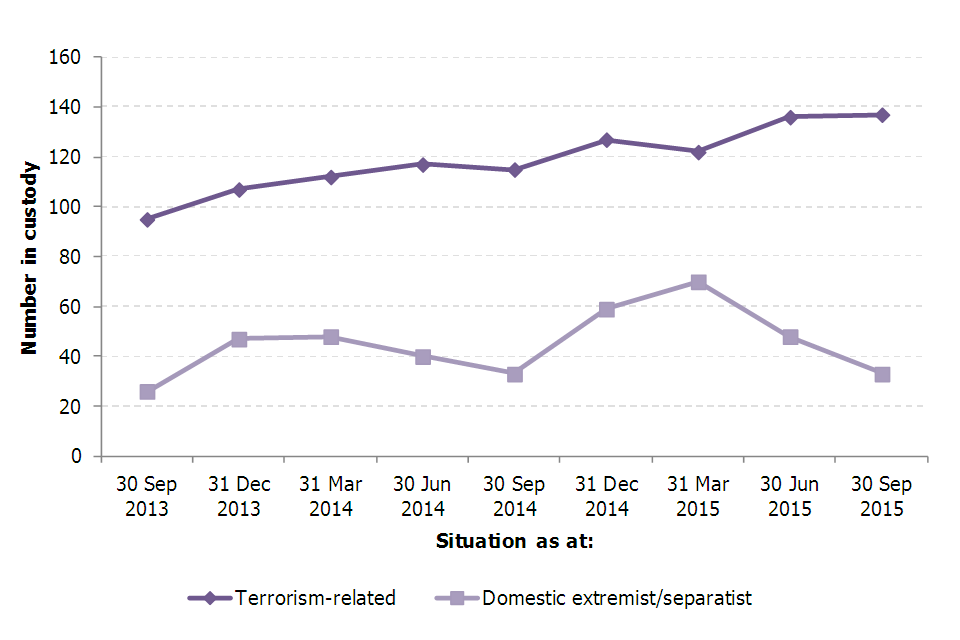
Not supplied by author.
Source: Home Office, data tables P.01.
The demographic breakdown of those in custody differed between those in custody for terrorism-related offences and those in custody for domestic extremism/separatism.
As at 30 September 2015, of the 137 persons in prison for terrorism-related offences:
- 131 considered themselves Muslim
- 62% considered themselves to be of ‘Asian or Asian British’ ethnicity (excluding cases where ethnicity was unrecorded)
- 76% considered themselves to be of ‘British’ nationality (excluding cases where nationality was unrecorded)
As at 30 September 2015, of the 33 persons in prison for domestic extremism/separatism:
- 20 considered themselves to be Christian, and 8 considered themselves to have no religion
- the majority (32) considered themselves to be of ‘White’ ethnicity (excluding cases where ethnicity was unrecorded)
- the majority (31) considered themselves to be of ‘British’ nationality (excluding cases where nationality was unrecorded)
The nationality of those in custody for terrorism-related offences and domestic extremism/separatism was split across at least 18 different countries. In both cases, the majority of these were from the United Kingdom.
5.2 Persons released from custody
A total of 120 terrorist and domestic extremists/separatists were released from custody in Great Britain in the year ending June 2015, twice the number released in the previous year. Ninety-nine of the 120 releases were persons discharged from custody after serving their sentences, many of whom will have been released to licence conditions.
For more details on releases from custody, see the user guide.
5.3 Data tables
Additional data are available in tables P.01 to P.05 which accompany this release. These include more detailed breakdowns on:
- the ethnicity, nationality and religion of those in custody tables P.02 to P.04
- the sentence lengths of those released from custody table P.05
6. Stop and search
This section presents statistics on the use of stop and search powers available to the police under TACT 2000. It includes data on the number of stops and searches and resultant arrests, carried out under s.43 of TACT 2000 by the MPS. It also includes data on the number of examinations carried out in Great Britain under Schedule 7 to TACT 2000.
Data on section 43 stops and searches are provided to the Home Office by the MPS. Data on Schedule 7 are provided to the Home Office by the NCTPHQ. This section covers the number of stops and searches, and examinations that were carried out in the most recent 9 quarters to September 2015. This section also contains additional data, from April to September 2015, on the number of goods examinations, the number of strip searches and the number of times postponement of questioning was refused.
The police have the power to stop and search individuals under section 47A (previously 44) of the Terrorism Act 2000. However, since the legislation was formally amended in 2011, to significantly raise the threshold for authorisation of the power, there have been zero stops and searches under this power. See the user guide for more details.
6.1 Stop and search under the Terrorism Act 2000
Section 43 of TACT 2000 allows a constable to stop and search a person whom he reasonably suspects to be involved in terrorist activity. As many forces are unable to separate s.43 TACT stops and searches from other stops and searches, this section includes data from the MPS only and excludes ‘vehicle only’ stops and searches.
In the year ending September 2015, 473 persons were stopped and searched by the MPS under section 43 of TACT 2000. This represents an increase of 31% on the previous year total of 360. The proportion of persons searched under section 43 who were subsequently arrested was 8% in the year ending September 2015, 2 percentage points higher than the previous year.
In contrast, there has been a fall of 41% in all stops and searches conducted by the MPS in the year ending 31 March 2015 compared to the previous year. The arrest rate in the year ending 31 March 2015 was 19%, more than double the 8% arrest rate seen for s. 43 stops and searches. For further information on stop and search in England and Wales, see the Home Office ‘Police powers and procedures, England and Wales’ statistical releases.
Although there was a year-on-year increase in the number of stops and searches, Figure 6.1 shows the numbers fluctuate from quarter to quarter. The increase in the latest year was influenced by a relatively low number of searches carried out between April to June 2014 in the previous period, and a particularly high number of searches between October and December 2014 in the current period. Additionally, each quarter in the current period saw a higher number of stops and searches than the corresponding quarter in the previous period.
Figure 6.1: Stop and search carried out under section 43 of the Terrorism Act 2000, Metropolitan Police Service
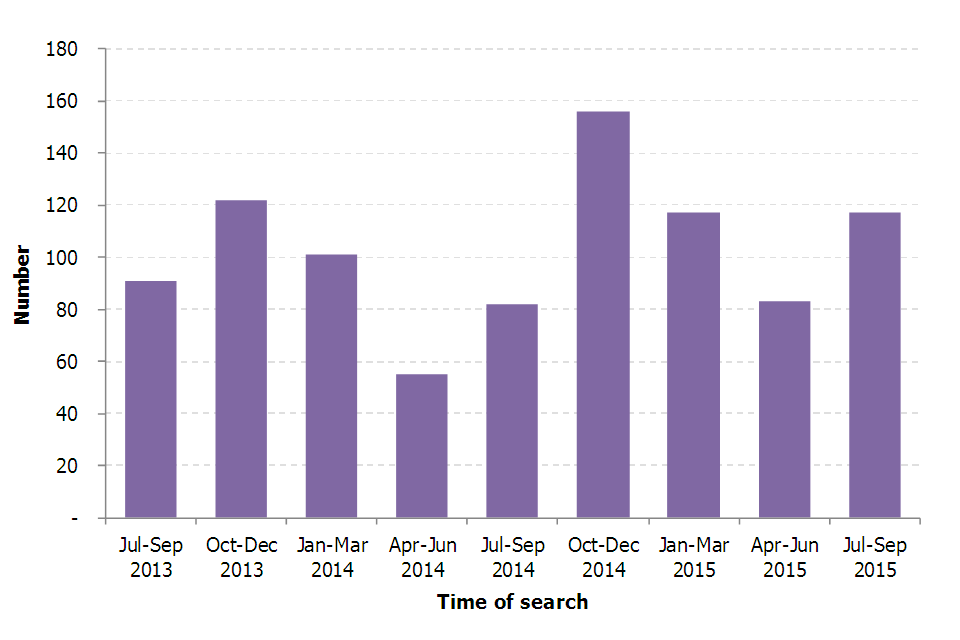
Not supplied by author.
Source: Home Office, data table S.03.
Chart Notes:
- Excludes ‘vehicle only’ searches.
The number of people stopped and searched under section 43 of TACT 2000 rose for every ethnicity between the year ending September 2014 and the year ending September 2015, with the exception of those who self-defined as ‘White’, which remained unchanged. Most noticeably, stops and searches of those who self-defined as ‘Asian or Asian British’ saw the largest increase, at 53% compared with the previous year.
6.2 Examinations under Schedule 7 to the Terrorism Act 2000
Schedule 7 to TACT 2000 allows an examining officer to stop and question individuals travelling through ports, airports, international rail stations and the border area. When necessary they may also detain and search individuals. The aim is to determine whether that person appears to be someone who is or has been concerned in the commission, preparation or instigation of acts of terrorism.
In the year ending September 2015, a total of 29,052 persons were examined under this power in Great Britain, a fall of 22% on the previous year. Initial thoughts around the likely causes of this fall include a more targeted approach when using the power, and a shift in focus to passengers leaving, rather than entering the country.
Throughout the same period, the number of detentions following examinations has almost tripled, from 684 in the year ending September 2014 to 1,810 in the year ending September 2015. The increase in the number of detentions follows the introduction of the Anti-social Behaviour, Crime and Policing Act 2014 in August 2014, which amended the powers under Schedule 7 to TACT 2000 to ensure that a mandatory detention takes place where an examination lasts for more than an hour.
Figure 6.2: Persons examined and detained under Schedule 7 to the Terrorism Act 2000, Great Britain

Not supplied by author.
Source: Home Office, data table S.04.
The fall in the number of persons examined was recorded across all ethnic groups except ‘Asian or Asian British’ which saw an increase of 2% in the year ending September 2015 compared with the previous year. The most notable falls were seen for ‘White’ and ‘Black and Black British’, which saw respective falls of 37% and 30% in the year ending September 2015 compared with the previous year. The increase in the number of detentions was seen across all ethnic groups, most notably ‘White’ which more than tripled from 58 detentions to 214.
Excluding those who did not state their ethnicity, the proportion of all examinations accounted for by each ethnic group in the year ending September 2015 differed from the previous year for certain ethnic groups. The proportion of those examined who considered themselves to be:
- ‘White’ fell by 9 percentage points (from 42% to 33%)
- ‘Asian or Asian British’ increased by 7 percentage points (from 24% to 30%)
- ‘Chinese or Other’ increased slightly (from 20% to 23%)
6.3 Additional Schedule 7 data
From April 2015, the NCTPHQ started collecting additional data on Schedule 7 to TACT 2000. This includes data on the number of strip searches and the number of times postponement of questioning was refused by the examining officer, as well as accurate breakdowns of goods examinations by type of freight (air and sea). These additional datasets have been included in this publication for the first time.
Goods examinations
Goods are defined non-exhaustively under paragraph 9 of Schedule 7 as “property of any description, and containers”. The Counter-Terrorism and Security Act 2015 clarified the legal position around the examination of goods in remote storage outside the immediate boundary of a port and the examination of goods comprising items of post. A goods examination under Schedule 7 may only be carried out by a trained, accredited and designated examining officer. An examining officer may only examine goods for the purpose of determining whether they have been used in the commission, preparation or instigation of acts of terrorism.
Between 1 April and 30 September 2015 a total of 2,152 air freight and 2,879 sea freight examinations were conducted. Falls were seen in the number of both air and sea freight examinations conducted in the most recent quarter (July to September 2015) compared with the previous quarter (April to June 2015).
Strip searches
A strip search is a search involving the removal of more than outer clothing. Strip searches do not extend to requiring a person to undergo an intimate search (searching a person’s body orifices other than the mouth). A strip search may only take place where an examining officer has reasonable grounds to suspect that a person has concealed something which may be evidence that the person is a person who appears to be or to have been concerned in the commission, preparation or instigation of acts of terrorism. The search must be authorised by an officer of at least one rank higher than the examining officer and who has not been directly involved in the questioning of the person. Strip searches can only be conducted when a person has been detained. The Schedule 7 Code of Practice sets out the procedures an examining officer must follow when conducting a strip search.
Between 1 April and 30 September 2015, 7 persons were strip searched under Schedule 7 to TACT 2000.
Postponement of questioning refusals
A person being examined under Schedule 7 is able to request that their examination be postponed in order for them to be able to consult with a solicitor. If reasonably practicable, an examining officer must allow this. However, a request for postponement may be refused if the examining officer considers that postponing the questioning would prejudice the purpose of the examination.
Between 1 April and 30 September 2015, postponement of questioning was refused 3 times.
6.4 Data tables
Additional data are available in tables S.01 to S.04 which accompany this release. These include more detailed breakdowns on:
- the ethnicity of those stopped and searched tables S.02 and S.03
- the ethnicity of those arrested table S.02
- Schedule 7 examinations and detentions table S.04
7. Consultation
The small number of respondents to our recent consultation of users came from a number of areas, both within the Home Office, and externally (such as police forces and other government departments). The main findings from the user survey are listed below:
- the most used part of the publication was the data tables
- while the reliability and quality assurance of the statistics was seen as the most important part of the statistics, the data tables and timeliness of publishing the statistics were also seen as highly valued
- all topics within the bulletin are used by various users
In response to the survey, we have brought forward the publications of these statistics, whilst maintaining the same level of detail in the data tables, and continuing to ensure the data are quality assured to a high standard.
